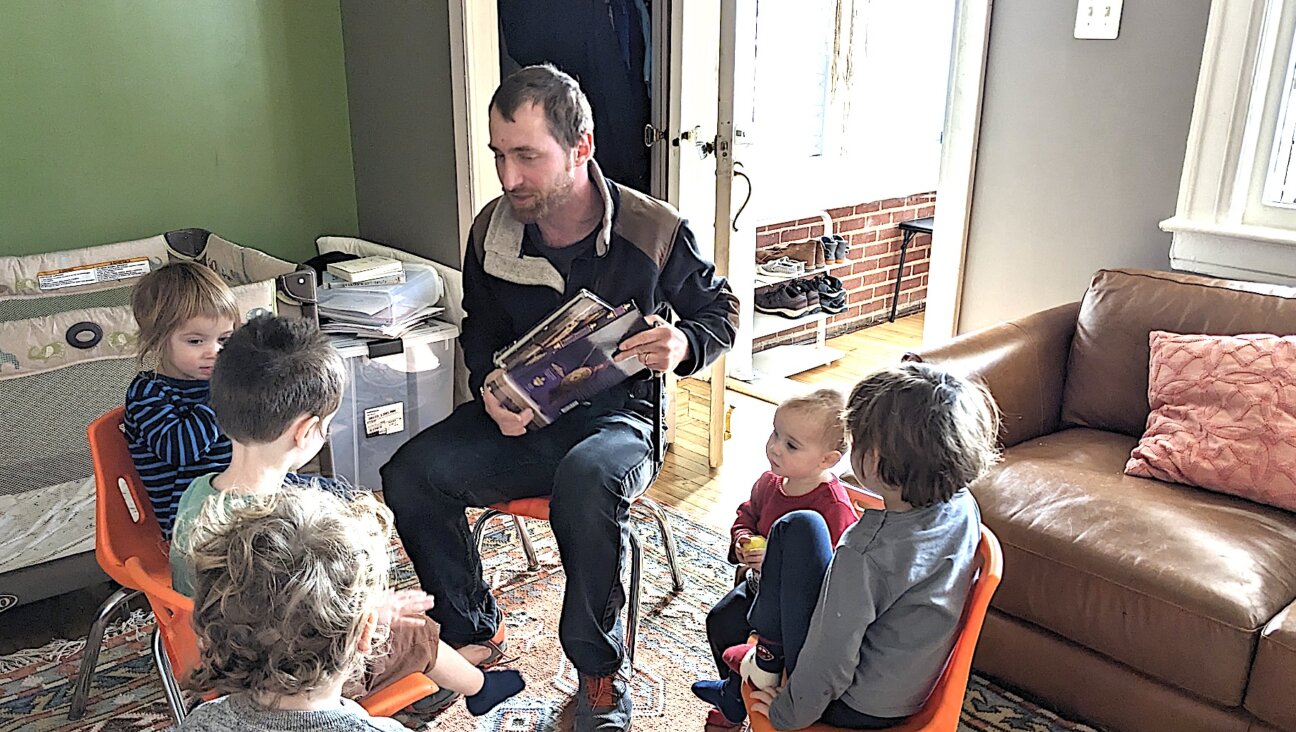Orthodox World Provides Backdrop for Rama Burshtein’s Universal Story

Image by sony pictures classic
The night before Rama Burshtein shot the last scene of “Fill the Void,” she couldn’t sleep. It was going to be her last day on set, and a large group of extras was scheduled to arrive, including her own children. More daunting, she was going to be shooting a wedding scene, one of the film’s crucial moments.
“I was crying and saying: ‘Listen, God, I know what it is to get married. This is really holy. This is really deep. You can never shoot that,’” Burshtein recalled. “And I was crying because suddenly I didn’t understand what I was doing.”
Burshtein, 46, was sitting in a suite at the Waldorf Astoria hotel in Midtown Manhattan, fielding questions prior to the film’s American release on May 24. She is a heavyset woman with an energetic interview style that suggests both candor and confidence. Her head covering — a pink, turbanlike affair matched with gold earrings and a black dress — stood out against the Waldorf’s avocado wallpaper.

An Unorthodox Journey: Writer-director Rama Burshtein holds court in the Waldorf Astoria. Image by Nate Lavey
Next to her on the sofa, Hadas Yaron, the 23-year-old star of the movie, curled up and listened with admiration as Burshtein recounted the morning of the shoot.
“I went to the set, and the weirdest thing happened,” Burshtein continued. “Everyone was different. The photographer, the actors, everyone was feeling differently than the day before. [Hadas’s] father — her real father — walked in and started crying because he saw his daughter in a wedding dress. It didn’t feel like we were making a movie.”
The scene is the culmination of a struggle that has been going on throughout the film: whether 18-year-old Shira Mendelman (Yaron), a Hasidic woman from Tel Aviv, will sacrifice the opportunity to marry a boy her own age in order to wed her late sister’s husband and keep her family together.
Since it premiered in 2012 at the Venice International Film Festival, where Yaron won the Volpi Cup for best actress, “Fill the Void” has become the latest darling of Israeli cinema. At home it won seven Ophir Awards, including best film and best director, and has been praised widely for telling a story of universal appeal, despite being extremely specific in its details.
If not for her talent, Burshtein’s own story would not be much different from that of thousands of other Israelis who made a midlife journey to Orthodoxy. Born in New York, she moved with her parents to Israel at the age of 1. Later, she attended the Sam Spiegel Film & Television School, in Jerusalem, where she cut a memorable figure, distinguishing herself by her skill and her forthright personality.
“Rama was an opinionated, charismatic and sharp student,” wrote Renen Schorr, the school’s founding director, in an email to the Forward. “She was without a doubt an outstanding directing talent.”

Hadas Yaron, the 23-year-old star of ?Fill The Void.? Image by nate lavey
After graduating, Burshtein took a turn that few of her friends expected. Instead of pursuing a career in film, she became religious, got married and had four children, now all teenagers. “It is clear to me that the price she paid, consciously, was very high,” Schorr wrote. “Especially as she dedicated herself to her home and family, supposedly giving up filmmaking.” Though she taught film and made a few minor movies for a Haredi audience, she seemed to abandon the life of a mainstream filmmaker.
With “Fill the Void,” however, Burshtein’s 20-year absence from the Israeli film industry has turned out to be only a hiatus. According to those who know her best, she never gave up filmmaking at all.
“I know a lot of people who became religious, and sometimes they become another person in a minute, but Rama stayed herself,” said Tali Shemesh, a documentary filmmaker whose credits include “The Cemetery Club,” a 2006 film about a group of seniors who hang out in the Mount Herzl Cemetery.
Shemesh went to film school with Burshtein and describes their relationship as “like sisters.” “She had this creativity always — and it never died — to write and tell stories,” she said.
According to Burshtein, the inspiration for “Fill the Void” came from a friend of a friend who had married her brother-in-law after her sister’s death. That situation, with its wealth of emotional possibility and conflict, stayed with her, and she turned it into a script. Shemesh put her in touch with Assaf Amir, a producer.
“I fell in love with the script,” Amir told me over the phone from Tel Aviv. “After I read the first draft, I told Rama that the film could have been shot in Poland 200 years ago, in New York, in Tel Aviv. It was that kind of film we were making.”
At the beginning of “Fill the Void,” we see Shira with her mother, Rivka (Irit Sheleg), nervously scouting a potential match in the dairy aisle of the supermarket. “You’ll have to do a lot of laundry,” her mother remarks skeptically, as the man wipes his glasses on his shirt. Shira, however, is impressed. A smile plays on her lips as she admires her potential suitor.
But events soon take a tragic turn. Shira’s sister, Esther (Renana Raz), dies during childbirth, leaving behind her husband, Yochai (Yiftach Klein), and a newborn son, Mordechai. When Yochai receives a marriage proposal from a family in Belgium, Rivka conspires to have him marry Shira instead, so as not to lose her only grandson. The idea might seem outrageous — and does seem outrageous, at first, to both Shira and Yochai — but the emphasis of the story, and of Yaron’s performance, is on Shira’s struggle with feelings of duty, desire and love.
“It wasn’t about being a religious girl,” Yaron said, explaining her approach to the character. “It’s about going through a process of growth, and growing up, and falling in love. It’s complicated, but it’s about emotions and choices that had to be made.”
Although female characters like Shira and Rivka are at the center of Burshtein’s story, “Fill the Void” presents a unique picture of a Hasidic family in other respects.
The film achieves a rare verisimilitude of speech and dress, bringing the viewer into what feels like a real Hasidic home, not a filmmaker’s facsimile of one. This extends even to the soundtrack, which, when we don’t hear male characters singing around the Sabbath table, or Shira playing the accordion, consists of contemporary Orthodox pop music.
More important, unlike most movies depicting the ultra-Orthodox, “Fill the Void” is not about a conflict between religious and secular societies, a crisis of faith or a struggle with forbidden desires, like homosexuality.
Instead, the movie is a “window,” as Burshtein describes it, into a world where people have their difficulties but are not all questioning their religion or trying to leave their communities. “I’m not into criticism,” she told me. “I’m into complication.”
Yet “Fill the Void” doesn’t attempt to gloss over aspects of Judaism that viewers might find unsavory — including the intense pressure to marry, which produces the story in the first place. As Burshtein rightly claims, it’s a question not of being critical, but of telling a story; Orthodoxy here is the setting, not the subject. And when it comes to love and marriage, she argues, the film’s depiction isn’t much different from that experienced by everyone else, no matter what their beliefs might be.
“But isn’t it more momentous?” I asked her, thinking of the youth and inexperience of most Orthodox newlyweds.
“Is it momentous for you as a secular person to find your true love, the love of your life?” Burshtein replied, leaning forward on the salmon-colored sofa.
“Because it’s the same,” she went on. “When you look at someone you meet and you feel that person’s the one…. That’s why people in the world like this film, I guess. Because it’s the same.”
Ezra Glinter is the deputy arts editor of the Forward. Follow him on Twitter @EzraG
Watch the trailer for ‘Fill the Void’:
















